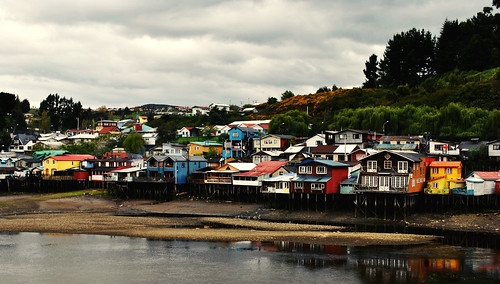
The islands of Chiloé and its beautiful landscapes. They are a land of unique identity, with fantastic stories and the intense flavor of its cuisine. This vast and desolate beach on which they break, furious waves of the South Pacific, seems the perfect place to display the Caleuche, which, although not daring to say so explicitly, we would like to view. The ancient people called this island chelles and that their passage into Castilian (chillwe means «place of chelles» in Mapuche language) finished giving name to this land so strange and fascinating: Chiloé in southern Chile.
Land of witches, legends and fishermen, peasants and pirates, Chiloé is a spell of green fields, fjords and channels, a rare landscape that refers to the hills of Ireland or the Scottish highlands, the South Pacific.
To be exact, I must say that Chiloé is an island but an archipelago, the Big Island also includes a large number of other islands and smaller islands, which host a total of about 160 thousand inhabitants. And home, above all, a particular history, a culture very own by mixing Indian and Hispanic traditions, on the island environment, by isolating the area where he lived for a long time and for a number of legends and myths astounding for its originality and inventiveness.
Isla Grande of Chiloe
It is rare to see a path that literally go straight to sink into the sea. But what about Chile Route 5, which rises well north border with Peru and travels the country as a backbone. But Pargua port, opposite the Isla Grande de Chiloé, the tongue of asphalt is submerged in the Chacao channel. They rob the famous ship that cross the canal, at one time feared for sailors and has seen more than a legendary shipwreck.

Getting to Chiloe in the evening may not be advisable unless you know the path (bus and truck traffic is heavy), although it may be an advantage if you are lucky enough, for example, to see the moon appearing after the Cordillera de los Andes, magically reflected in water. O come late to a cabin perched on a hilltop on the outskirts, to see the lights twinkling in the fjord and surprised by the landscape of the early morning light: green meadows that sink in a sea of blue streaked by colorful fishing boats, wooden houses and fairy-like slender towers of wooden churches, but all the churches of the island. Here fortunately modernity seems to have arrived (asphalt, cars zero km, cellular signal in all corners, banks, services) gently, and with respect, without destroying what so many years he maintained.
Castro and palafitos:
Most towns and cities of the archipelago are concentrated on the Big Island, like Castro, who with about 40 thousand inhabitants is the capital of Chiloé province since, in 1982, snatched the title to Ancud. Founded in 1567 in the central area of the island, Castro is the third oldest city in Chile continued existence, and its history and chonos huilliches mix (original inhabitants of the area) with Spanish conquistadors, Jesuits, Franciscans and pirates in the 1600, the population was occupied for two months by the Dutchman pirate Baltazar de Cordes, later to be destroyed again by another Dutchman: Hendrick Brouwer.
In Chiloé also Ancud schooner was built, the first warship built in Chile, which departed from the archipelago to take possession, in 1843, the Strait of Magellan, on behalf of the nascent republic. The crew, consisting essentially of Chiloe, founded Fuerte Bulnes, Punta Arenas today.
Today, Castro streets in seesaw concentrated shops and services, including the classic wooden buildings lined with colorful larch tiles, with balconies and verandas and painted colors. The hub is the central square, opposite the Church of San Francisco (Heritage), whose original temple was destroyed by fire in 1902 and rebuilt in 1912. To protect it, the exterior was covered with sheets, but the inside is kept entirely of wood (including Cross and ornaments), and is dazzling. Its towers rise to 42 meters high, and were seen from several miles around.
A lovely walk is one that retraces Pedro Montt Avenue, two blocks from the square but several meters below, to the sea. The tour visits the port, a craft fair and stilt houses, unique wooden buildings on piles driven into the seabed, which arose to make better use of commercial bank expansion during the nineteenth century, and today there are only some examples in Castro and Mechuque, one of the islands Chauques. A beautiful postcard of the stilt houses, and downtown Castro perched on top of the hill, you get from the peninsula of Ten-Ten, a couple of miles north.

During the summer, and Sundays during the rest of the year, several sites offer curanto in hole, the most typical dish of Chiloé. It is prepared in a hole in the earth where hot stones are placed on top are layers of seafood, meats, sausages, vegetables and pulses, each layer separated by a typical plant leaves or nalca pangue call. A show not only for its taste but also for his long and elaborate preparation.
Chiloé Islands a unique experience in the South Pacific!
Leave a Reply
You must be logged in to post a comment.
Recent Comments